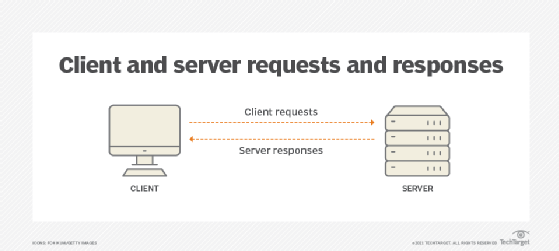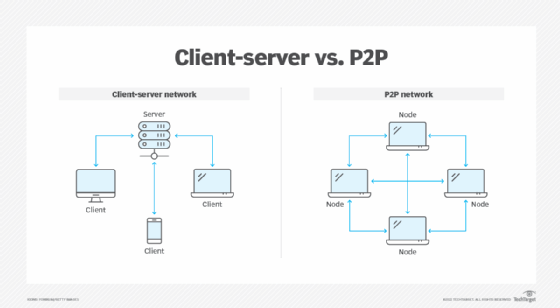client-server network
What is a client-server network?
A client-server network is a distributed communications architecture in which a centralized server receives and responds to requests for services and data from multiple clients. For example, a browser is the client program that requests data from the web server hosting WhatIs.com. This enables the webpage to be accessed by any device with an internet connection.
The client-server model is used in organizations of all sizes and complexities, from small businesses with 50 employees to large enterprises serving millions of customers. Servers are typically deployed in data centers where they can be centrally managed and maintained in an environment with adequate security, performance and redundancy. Client software and hardware can be located anywhere network connectivity is available.

What is the purpose of a client-server network?
The purpose of a client-server network is to share resources efficiently. This type of computer network makes the same digital services and data accessible to multiple users across a shared connection -- whether it's a local area network (LAN), wide area network or the public internet. The principal benefits of a client-server network are convenience, ease of deployment, improved resource availability, simplified management and scalability.
In a client-server network, a central server computer receives a client request and can do one of the following:
- Respond to the request directly.
- Route it to another server that can fulfill the request.
Examples of central servers include web servers, email servers, application servers and database servers. In the client-server network model, all requests for service originate from the client, and servers process the requests.
How does a client-server network work?
Each device in a client-server architecture is connected to a LAN, which transports network traffic over Ethernet between these endpoints. The network is designed to optimize the traffic flow among devices to minimize congestion and latency. The operating system in each device supports communications between the servers.
In a client-server network architecture, there are three tiers that refer to the different layers or levels of functionality within the system. These tiers are:
- Presentation tier. This top tier, also referred to as the user interface tier, is responsible for presenting information to the user and capturing user input. It includes the user interface components, such as web browsers, and mobile and desktop applications. This tier also handles the presentation logic and user interactions, ensuring a user-friendly experience.
- Application tier. The application tier is also known as the business logic or middle tier. It contains the core processing and logic of the system, and it handles application-specific functionality, business rules and processes. This tier communicates with the presentation tier, receiving user requests, performing necessary processing and returning results. It may include application servers, web servers and microservices that handle the application's logic and integration with other systems.
- Data tier. The data tier is also called the back-end tier or data storage tier. It's responsible for storing, retrieving and managing the system's data. It stores data in databases, file systems and other data storage systems. The data tier interacts with the application tier to provide users access to the required data. It ensures data integrity, security and scalability.
These three tiers work together to create a distributed system architecture, where each tier has its own set of responsibilities and communicates with the other tiers as needed. This separation of user interface, application and data concerns makes the client-server network architecture more scalable and modular, and easier to maintain.
Types of clients and servers in a client-server network
Both clients and servers have specific responsibilities in a client-server model. Thin clients, thick clients and hybrid clients are the three types of client computers and client-side devices:
- Thin clients have minimal processing capabilities and depend mostly on the servers to which they connect.
- Thick clients handle most of their processing locally and depend minimally on servers.
- Hybrid clients exhibit characteristics of both thick and thin clients, such as performing local processing but with greater dependence on servers for functions such as data transmission and management.
The responsibilities of servers in a client-server network vary depending on the type of server -- web server, file server or database server, for example -- and the network architecture requirements. Server-side functions include the following:
- Handling client requests. Servers receive and process resource and service requests from client devices.
- Serving resources and services. Servers provide the requested resources or services to clients, such as web pages, files, data and applications.
- Managing and controlling access. Servers manage access to resources and services by validating client credentials, enforcing security measures, and ensuring authorized client access to specific resources or functions.
- Storing and managing data. Database servers handle data storage and retrieval, ensuring data integrity, consistency and security.
- Processing and executing tasks. Servers in a client-server network process data and perform computationally intensive calculations and analysis for clients.
- Maintaining uptime and performance. Servers ensure the uptime and performance of network services and resources.
Pros and cons of client-server networks
Client-server systems have numerous benefits, including these:
- Dedicated servers are optimized for their specific task and equipped with more powerful hardware than a standard computer, all of which enhances speed, performance and reliability.
- Servers are centrally managed, which is important from a security perspective to ensure the latest security updates are implemented across the network.
- Client-server networks are scalable. If greater capacity is needed, another server can be added with minimal disruption to other clients on the network.
- Access to data and data management resources is simplified by being managed by the server.
Client-server networks have some disadvantages, such as the following:
- Servers are expensive, requiring significant upfront investment and skilled staff to manage them. Because servers can overheat easily, they must be maintained in a temperature-controlled environment, which adds to energy costs.
- From a performance standpoint, a single server without sufficient redundancy represents a single point of failure in the event of a hardware or software malfunction.
Client-server vs. peer-to-peer networks
Peer-to-peer (P2P) network architecture differs from client-server in that each device on the network functions as both client and server, depending on the requirements. A defining trait of P2P networks is that all nodes are connected, and they can share resources and services with other nodes on the network. However, each node operates independently, and an algorithm is used to balance the load.

For example, if one computer on a P2P network is directly connected to a printer, another computer on the same network can access that service without the need for a dedicated print server. This architecture works well for small environments, but network performance deteriorates the larger and more complex a P2P network becomes. Because all nodes are interconnected, P2P networks also possess significant security risks.
Learn more about servers and server management in our guide to server hardware.








